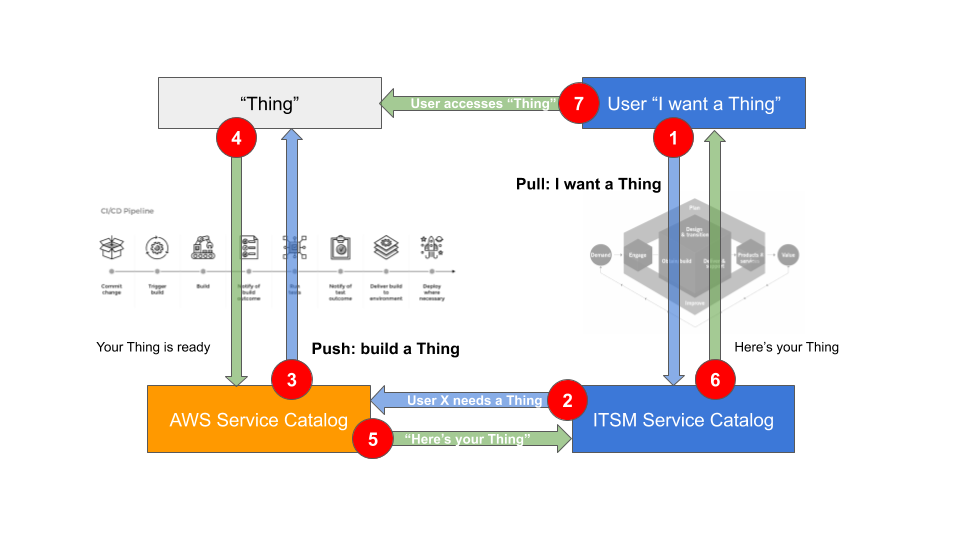
How ITSM Pull Meets DevOps Push
You’re probably “all hands to the pumps” right now in your IT organization. Ensuring that customer needs are still being met and that employees can continue to work in light of the new business homeworking policies that reflect self-isolation and potentially government-decreed lockdowns. I hope that you’re both safe and successful with this over the coming weeks and months.
You likely have little time for learning right now but, if you do, here’s a blog on how IT service management (ITSM) and DevOps should be used together. Hopefully, it will be helpful once the time comes to take our respective organizations forward, as the world returns to some semblance of normality.
A lot has already been written about IT service management (ITSM) and DevOps. Much of it angled at ITSM versus DevOps or, more cynically, how DevOps will be the death of ITSM. Thankfully, some leading DevOps luminaries appreciate the need for both ITSM and DevOps, working together to ensure that IT will ultimately deliver against business needs for innovation and technology-enabled services. So, rather than doing a compare and contrast of DevOps and ITSM, how about some practical advice on how they can work together?
Please keep reading to find out more.
Here @Cloud_Stevie shares some practical advice on how #ITSM and #DevOps can work together. Click To TweetDevOps “versus” ITSM or DevOps and ITSM?
DevOps and ITSM are commonly two separate “things” in an enterprise – with different people, cultures, and tools. However, there are moves to get them to work together. The 2016 ITSM Practitioner book already included DevOps-esque guidance. With 2019’s ITIL 4 fully embracing the importance of DevOps and Agile to the future of ITSM.
To help you further, this blog offers a practical example of how organizations can effectively combine DevOps and ITSM using service catalogs.
ITSM pulls and DevOps pushes
If you’ve ever read anything on Theory of Constraints, or The Toyota Way, or the excellent books The Phoenix Project and The Unicorn Project by the equally excellent Gene Kim, then you’ll be familiar with the concepts of pull and push. Here’s an illustration of how these work in practice for everyday enterprise IT events:

DevOps can “push” things into the business. These can be internal or customer-facing things such as a new development environment, a desktop, or an update to the production customer facing system. The mechanism to push is often a Continuous Integration/Continuous Delivery (CI/CD) pipeline that automates the building of artefacts, moving them between systems, testing them – no human hands required.
Conversely, ITSM can “pull” things on behalf of users, similar to a “Just in Time” manufacturing line. These things are the same things that the DevOps team push, but the system that pulls is different to the one that pushes.
Imagine a new employee who needs access to a development environment. It needs to be built the same as every other developer’s environment, so the developer gets access to the ITSM system on their first day and orders their new environment. The ITSM system pulls the environment by telling the DevOps pipeline to create what it needs. But how does this really happen?
This blog by @Cloud_Stevie offers a practical example of how organizations can effectively combine #DevOps and #ITSM using service catalogs. Click To TweetHow two service catalogs work together
The secret to successfully combining DevOps and ITSM in practice is to connect their respective service catalogs.
The AWS service catalog allows technology teams to compose catalogs of IT services that are approved for use on AWS. These IT services can include everything from virtual machine images, servers, software, and databases to complete multi-tier application architectures and complete IT environments.
The ITSM tool service catalog provides a single source of consistent information on all services and service offerings to all users of an organization.
If you have #DevOps & #ITSM working together in your organization be sure to ensure that each is playing to its strengths for the benefit of all, says @Cloud_Stevie. Click To TweetA classic combination is a new developer employee ordering a development system from the ITSM service catalog. The ITSM system checks authorization and approvals and triggers a value chain which pulls the environment from the cloud service catalog. The cloud service catalog item will execute a CI/CD pipeline to push a new environment out and tell the ITSM system when it’s ready. The ITSM system completes the value chain and gives the developer “the keys” to their new environment.
Next steps for bringing your DevOps and ITSM together
Let the Cloud/DevOps push and ITSM pull systems be experts in their domains, and no more. And let the CI/CD pipeline and all the required technical complexity sit in the cloud.
The value chain of delivering a product or service to a real person such as a new developer employee should reside in the ITSM system. Here the ITSM service catalog hides the complexity of the value chain from the end user. And the Cloud/DevOps service catalog hides the complexity of cloud/DevOps from the ITSM system.
The public cloud leader, AWS, is most advanced in this area. Its highly programmable AWS service catalog can provision all the cloud services any cloud expert would need – but you need to be a cloud technologist, and get into the detail, to use it.
The good news for non-technical ITSM practitioners is that AWS exposes its service catalog via an API which means that any ITSM system can “pull” items from the AWS service catalog, and ready-to-go integrations between ITSM tools and AWS are available today.
So, look to have DevOps and ITSM working together in your organization. Just be sure to ensure that each is playing to its strengths for the benefit of all.






